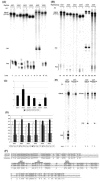Efficient expression of the adeno-associated virus type 5 p41 capsid gene promoter in 293 cells does not require Rep
- PMID: 16775342
- PMCID: PMC1488976
- DOI: 10.1128/JVI.00387-06
Efficient expression of the adeno-associated virus type 5 p41 capsid gene promoter in 293 cells does not require Rep
Abstract
Efficient expression of the adeno-associated virus type 5 (AAV5) P41 capsid gene promoter required adenovirus E1A and/or E1B; however, in contrast to what was observed for expression of the AAV2 capsid gene promoter (P40), neither adenovirus infection nor the large Rep protein was required. Although both the AAV2 and the AAV5 large Rep proteins efficiently bound the (GAGY)(3) Rep-binding element, the AAV5 large Rep protein transactivated transcription of the inducible AAV2 P40 promoter much less well than AAV2 large Rep. Differences in their activation potentials were mapped to the amino-terminal region of the proteins, and the poorly transactivating AAV5 Rep protein could competitively inhibit AAV2 Rep transactivation.
Figures




Similar articles
-
Upstream AP1- and CREB-binding sites confer high basal activity on the adeno-associated virus type 5 capsid gene promoter.J Virol. 2007 Mar;81(6):2605-13. doi: 10.1128/JVI.02313-06. Epub 2007 Jan 3. J Virol. 2007. PMID: 17202218 Free PMC article.
-
The transcription strategy of bovine adeno-associated virus (B-AAV) combines features of both adeno-associated virus type 2 (AAV2) and type 5 (AAV5).Virology. 2008 Jan 20;370(2):392-402. doi: 10.1016/j.virol.2007.09.007. Epub 2007 Oct 17. Virology. 2008. PMID: 17939931 Free PMC article.
-
Adeno-associated virus type 2 p5 promoter: a rep-regulated DNA switch element functioning in transcription, replication, and site-specific integration.J Virol. 2007 Apr;81(8):3721-30. doi: 10.1128/JVI.02693-06. Epub 2007 Jan 31. J Virol. 2007. PMID: 17267512 Free PMC article.
-
Characterization of the transcription profile of adeno-associated virus type 5 reveals a number of unique features compared to previously characterized adeno-associated viruses.J Virol. 2002 Dec;76(24):12435-47. doi: 10.1128/jvi.76.24.12435-12447.2002. J Virol. 2002. PMID: 12438569 Free PMC article.
-
Expression profiles of bovine adeno-associated virus and avian adeno-associated virus display significant similarity to that of adeno-associated virus type 5.J Virol. 2006 Jun;80(11):5482-93. doi: 10.1128/JVI.02735-05. J Virol. 2006. PMID: 16699028 Free PMC article.
Cited by
-
Positive and negative effects of adenovirus type 5 helper functions on adeno-associated virus type 5 (AAV5) protein accumulation govern AAV5 virus production.J Virol. 2007 Mar;81(5):2205-12. doi: 10.1128/JVI.02312-06. Epub 2006 Dec 13. J Virol. 2007. PMID: 17166904 Free PMC article.
-
Adeno-associated viruses can induce phosphorylation of eIF2alpha via PKR activation, which can be overcome by helper adenovirus type 5 virus-associated RNA.J Virol. 2007 Nov;81(21):11908-16. doi: 10.1128/JVI.01132-07. Epub 2007 Aug 22. J Virol. 2007. PMID: 17715234 Free PMC article.
-
Highly divergent integration profile of adeno-associated virus serotype 5 revealed by high-throughput sequencing.J Virol. 2014 Mar;88(5):2481-8. doi: 10.1128/JVI.03419-13. Epub 2013 Dec 11. J Virol. 2014. PMID: 24335317 Free PMC article.
-
Upstream AP1- and CREB-binding sites confer high basal activity on the adeno-associated virus type 5 capsid gene promoter.J Virol. 2007 Mar;81(6):2605-13. doi: 10.1128/JVI.02313-06. Epub 2007 Jan 3. J Virol. 2007. PMID: 17202218 Free PMC article.
-
Improved splicing of adeno-associated viral (AAV) capsid protein-supplying pre-mRNAs leads to increased recombinant AAV vector production.Hum Gene Ther. 2008 Dec;19(12):1421-7. doi: 10.1089/hum.2008.118. Hum Gene Ther. 2008. PMID: 18785816 Free PMC article.
References
-
- Hickman, A. B., D. R. Ronning, R. M. Kotin, and F. Dyda. 2002. Structural unity among viral origin binding proteins: crystal structure of the nuclease domain of adeno-associated virus Rep. Mol. Cell 10:327-337. - PubMed
-
- Hickman, A. B., D. R. Ronning, Z. N. Perez, R. M. Kotin, and F. Dyda. 2004. The nuclease domain of adeno-associated virus rep coordinates replication initiation using two distinct DNA recognition interfaces. Mol. Cell 13:403-414. - PubMed
Publication types
MeSH terms
Substances
Grants and funding
LinkOut - more resources
Full Text Sources
Other Literature Sources

